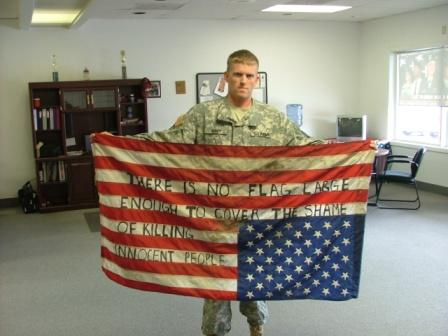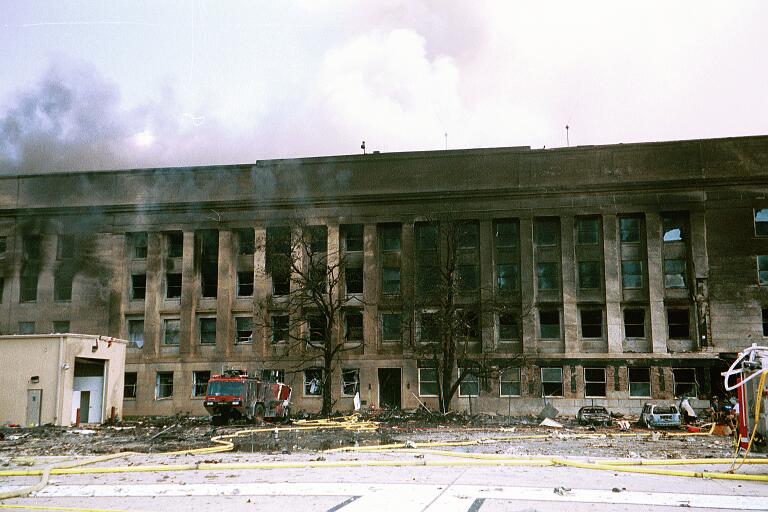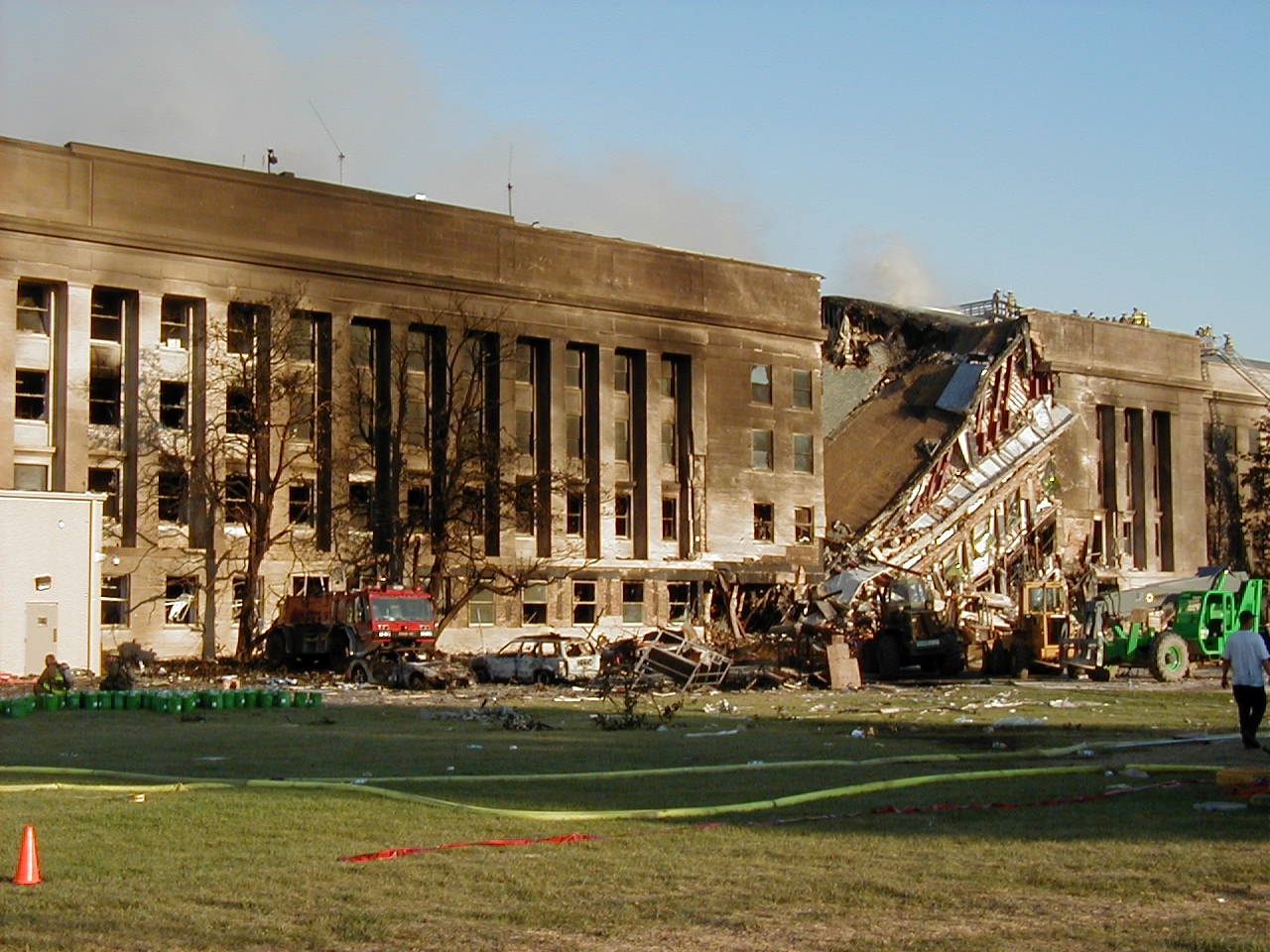The 50 minute's worth of interviews posted alongside, On Memorial Day, recalling the fight to save the Pentagon, go a long way toward explicating a truth lying hidden beneath the hagiography Newman and Creed constructed. It must be Doyle's intimacy with his subjects that results in the degree of openness and apparent sincerity we see in the interviews. Unfortunately for them, seeing with greater transparency the inconsistencies that make up the implausible "official conspiracy theory," only adds to the absurdity of the OCT.
- Video | Extended interview with Chief Jim Schwartz
- Video | Extended interview with Capt. William Bennett
- Video | Extended interview with firefighter Justin Scott
- Video | Extended interview with Capt. Joe Lightfoot
- Video | Extended interview with Capt. David Hehr
Doyle gets it wrong from the very start though, with the fake-sounding squawks of apparently official radio traffic--he then histrionically narrates,
"It is 9:38 in the morning of September 11th, 2001, terrorist hijackers have just flown American Airlines Flight 77 into the west face of the Pentagon. The airplane had been turned into a 270,000 pound missile, moving at nearly 400 miles per hour. When it hits, the men and women of the Arlington County Fire Department are at war. It will be up to them, and their brethren to save the nation’s military command center, the stricken heart of the nation’s might."
Having upped the stakes so significantly, why does Doyle lead off with a firefighter who was a rookie on 9-11, a NooB who still seems like the wrong lightweight choice for anything war stricken--a nonetheless charming and attractive Lieutenant Justin Scott, who gushes,
"I got on my cell phone and I called my mom...giggle...I was like, mom! I’m going to the Pentagon! And it’s funny, because she said that...ah, the message—she wishes that she would have kept it—all she heard was the sirens in the background….and she heard…
Doyle couldn't have made the point any stronger if he had tried, (and I am assuming he wasn't trying,) that whatever the mutual aid agreement between Arlington County and the Pentagon was, it was predicated on the exploding coffee-pot kind of fire, and not an instantly recognizable act of war, which would obviate any understandings. The deference supposedly paid ACFD by the FBI, (and paid the both of them by the DoD,) was a drilled component to a foreknowledged story that was badly written from the start. Was the Japanese attack on Pearl harbor considered an "act of terror," or an "act of war?" A crime scene or a war zone?
The sound of one firefighter's voice artistically fades as it blends with another, but it is a visual I want to direct your attention to now. Doyle uses some well-known, and a few unknown, Pentagon images for his montaging. But an unconscious confession is afoot, with the image a grand jury will use to bring up an indictment for arson--that of the Pentagon roof erupting in flame during the night--but here the image has been abstracted, out-of-focus, into some kind of code. This is repeated again, as though we might miss the point.
The next fireman begins. We are told for some reason, that a physical injury kept Captain David Hehr from assuming firefighting duties when the Pentagon was attacked on 9-11, as though his experience as a transportation officer—directing crews in and out of the site--wasn't properly considered a firefighter's duty.
"…When you’ve got five helicopters hovering over top of you saying we want a place to land, and you’ve got 25--let’s say, you’ve got thirty--ambulances on the way, and you’ve got to figure out where you’re going to put them and how you’re going to control them; nobody’s on the same frequency; cell phones don’t work; it got a little crazy there for awhile…."The reason this sounds like both whining and grandstanding to me is because the amended Arlington County After-Action report states that only 49 people were admitted to the hospital, and many of them were transported by private vehicle, or by any number of other services, such as Alexandria EMT, running triages in the center court, or in the North Parking lot. How many people were legitimately transported from this staged staging area? If Firefighter Hehr was having trouble stage managing his resources, he should get off the stage, and let an experienced actor take over his manufactured role.
In his extended interview, Hehr is asked, "when did you arrive to the Pentagon? What did you see?" and he responds:
"Immediately, I was there within the first five minutes of the incident. We pulled up to the Pentagon, we actually came into South Parking in the area, it would be, it was the same side of the building that the plane had impacted on the Heliport side, we were right at the corner of the building, there was a construction trailer"Hehr, rhetorically asks:
"How long did it take to get transportation under control? Probably about three hours,"although he admits that,
"If you weren't transported in the first hour and a half you were deceased,"which is an 100% exaggeration above other reports that put the window of opportunity for rescue at only the first 40 minutes.
Next up in the lineup is Captain William Bennett, who was off-duty that morning, but drove the 75 miles into Falls Church Station. Interestingly, he makes a comment in the little narrative video that is missing from his extended interview video. It was probably edited out for reasons of taste.
“I remember walking through the hallways and offices and there were people who were burned up and there was very little left to see of them other than bones. As a matter of fact, I remember telling one of my guys, 'hey, you’re standing on somebody, you might want to scoot to your left a little bit.'”
Lieutenant (9-11 rookie) Justin Scott, seems incapable of telling a believable lie.
"I saw complete devastation—I’ve…I didn’t know what to expect and—I, it just pretty much hits you right there, all I saw was bits and pieces of what looked like a plane, I saw, what I think, what I remember the most was the letter C, um, from the American Airlines, all I saw was piece that had the letter C on it, um, and just this massive amount of smoke and fire, and people just running out, I mean people everywhere just running away, and here we are getting ready to go in, it was crazy."
When asked, When did you hear about the Pentagon? Lieutenant Justin Scott says that he responded to his Chief’s orders to suit up.
“They say we were dispatched—I didn’t hear it.”
Justin describes the ride to the crash site.
"Mike Avery was driving."
Justin describes what he saw on arrival at the Pentagon.
"Fred Calvert was driving."
Lieutenant (then rookie) Justin Scott, wins the grand prize for most satirical statement made in good humor:
"There was more flames than you can imagine, and I didn’t think about it at first, but jet fuel was burning, and trying to put water on jet fuel—it just wasn’t really working. There was an incredible amount of fire."
When asked the question: How long were you fighting fire? Lieutenant (then rookie) Justin Scott says,
"I was out fighting fire…man…call came around 9:30, we, th...th...I can’t give an accurate answer because we were fighting fire, and this is before the section of the Pentagon had collapsed, we were in that building, and so, when it happened, when the collapse happened they were saying another plane was coming and we heard emergency evacuation tones also and they said that was because the collapse was to happen, (9:55/3:18 recovering VERY quickly,) you know, the collapse was falling in and we were inside the building and they didn’t want us in there so they were telling us to evacuate the building. So, we were in the building fighting fire for initially, to me it felt like forever but for sure ten, not even ten minutes or so, and they telling everyone to get out because the building is collapsing and that’s when that section of the building collapsed."
In this way, the very personable Justin Scott reveals two important components from his tour of duty.
One, the collapse of the tiny flap of the E-ring, was a planned synthetic event caused by pre-placed explosives, for which he was forewarned, and for which he tried his damnedest to lie convincingly--but failed utterly.
Two, tours of firefighting duty were manufactured synthetic events like a ride in an amusement park, with fire coming up out of some gas jet type facility. Firemen would go in for 10 or 20 minutes to ineffectually squirt some water, only to leave. Their myths of heroism and service are based on nothing more. The frauds.
Lastly with Justin Scott: do listen to him answer the question: "Did you require medical attention?" He is an absolutely disarming chap!





